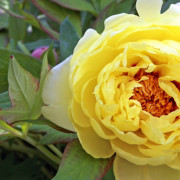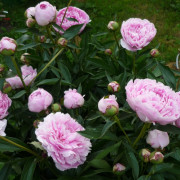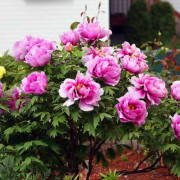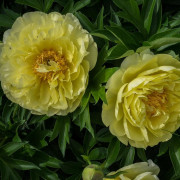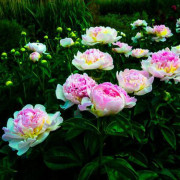Peony Etched Salmon (Paeonia Etched Salmon)
Content:
The botanical encyclopedia contains a description of 5 thousand varieties of peonies. Among this variety, Etched Salmon peony occupies a special place. A flower that is hard not to admire.
Peony Etched Salmon (Paeonia Etched Salmon) - what kind
The peony was "domesticated" by people thousands of years ago. In the wild, he is no longer met. Southeast Asia is considered the homeland.
Making hybrids is a tricky business. It takes decades to develop one variety. Nevertheless, scientists are engaged in this painstaking work. The Etched Salmon peony was the result of such experiments by Canadian breeders.
Description, characteristic
Etched Salmon is a herbaceous ornamental plant. It resembles a rose in shape and aroma.
What culture looks like:
- The bush is compact and neat, up to 80 cm high. It is resistant to rain and wind.
- Stems are resilient, erect, strong. Each ends with a bud. There are no lateral flowers.
- The leaves are large, petiolate, medium green.
- High decorativeness.
- Flower. The color is pink, coral shade, with a golden border around the edges. During flowering, it changes several times, but does not fade in the sun. The petals are corrugated, narrow in the center, wide at the edges, curved outward. The size of the flowers is the same - 16-17 cm in diameter.
- The aroma is delicate, not intrusive, with faint lemon notes.
- The roots are fibrous, located close to the soil surface.
The culture is characterized by slow development. The one-year-old plant does not bloom. In the second year after planting, several buds are observed.
Advantages and disadvantages
Peonies have many admirers who unite in clubs and societies. On the forums, they discuss the advantages and disadvantages of varieties, share their cultivation experience.
Among the advantages of the Etched Salmon peony are:
- Early-middle time of blooming of buds - already in June you can admire a flower in flower beds and ridges. Bloom within 4-5 weeks.
- Great smell.
- Gorgeous color and rose-shaped buds.
- Delicate aroma.
- Resistance to diseases inherent in the species.
- Unpretentious care.
The disadvantage is the high cost of seed. For one deal, they give about 2,500 rubles (the cost is relevant in the fall of 2019).
Use in landscape design
Etched Salmon stand out brightly at the club. Their decorative qualities are used by professional designers, summer residents, owners of country estates.
A retro trend is considered fashionable when a single bush is planted near a garden bench or swing. The best framing and background for Etched Salmon is even, bright green lawn, if it's wide enough.
- Bright red garden geranium, or white tansy, is suitable as partners for the peony. This is an equal partnership.
- Violets are planted right under the peony bush. If you want contrast, a foxglove is planted next to it.
Simple garden paths with a peony instead of a border look original. The charm is not lost even when the peony has faded, because the foliage of the plant looks quite decorative. It does not dry out after flowering, it remains juicy and green until late autumn.
Growing a flower
The peony grows in one place for a long time. Eight to ten years is not the limit. Landings that are 30 years old are observed. The culture does not like transplants, so the location is chosen carefully.
Site selection, soil preparation
The main enemy of the peony is groundwater. A bedding close to the surface will destroy the root system of the Salmon peony. In the lowlands, it is not planted for the same reason.
The place is chosen sunny, or with diffused partial shade. Cold drafts are not allowed. Better ventilated hillock.
Fertile soils with low acidity are suitable. The peony takes root well on loose loam. Acidic soils are treated with dolomite flour, lime, ash in order to normalize the pH level - its value should not exceed 5.5-6.0 units.
Before planting, the site is dug up onto 2 bayonets of a shovel. They remove the roots of weeds, stones, debris. Compost or leaf humus is introduced. No manure needed. Before landing, the earth is resting, saturated with oxygen.
The texture of the soil is corrected with sand, clay, humus.
Landing time, choice of planting material
Etcher Salmon peonies are planted in early autumn. Planting material placed in a fertile environment will take root until frost and winter well under cover. In the spring, immediately after the snow melts, the protection is removed. The buds of the plant wake up early and start growing, so they will rot under cover.
Planting in spring will be effective if done early, but not in frozen soil.
A plant seedling is a cut taken from a 4-6 year old bush. You can determine age by sight. Rhizomes are thick, smooth, not lignified. Branches - 2-4 pieces. Each has thin adventitious roots up to 20 cm long. Pink and whitish spots indicate the onset of infection.
Each root has a stem and a growing point. There should be 3-5 of them in total. When there are more buds, they will quickly deplete the root system.
Cut stems. If they rot, then they were not treated with an antiseptic - such material is rejected.
The rhizomes are carefully examined. The thickening near the root collar, which does not resemble the rhizomes themselves, may turn out to be cancer. The nodules on the adventitious roots indicate a root nematode. Such seedlings are not suitable for breeding - they can affect the entire front garden.
Planting step by step
The technology for planting peonies is the same as planting shrubs. Be sure to observe the distance between the plants - they must be 1 m apart from each other. Then all the peony bushes will receive plenty of light and air.
Strand of work:
- Dig a cone-shaped hole with a diameter and depth of 50 cm. A spacious hole is needed so as not to damage the fragile roots.
- Drainage is poured at the bottom. If rainwater is retained in this place, a layer is made 20 cm. Stones, expanded clay, large pebbles, broken brick are used.
- Fall asleep with soil taken out of the pit. But pre-mix it with peat, sand, humus, ash.
- Place the rhizome in the middle.
- With care, sprinkle it with earth, wrinkle it with your hands so that there are no air voids left near the roots.
- The root collar is buried 3-5 cm.
- Water abundantly.
The procedure is completed by mulching with the material at hand: peat, straw, or dry soil.
Seed propagation
It is difficult to grow a peony from seeds at home - they germinate for 2 years. Moreover, the resulting plant loses its maternal properties. Flowering is achieved at 7-8 years of culture life. But most gardeners are unhappy and disappointing with flowering.
Peony Care Etched Salmon
If the plant is planted correctly, then there is almost no need to care for it. By and large, this is a plant that will survive without leaving.But for a highly decorative culture, some events are still held.
Watering
For a herbaceous peony, three obligatory watering is enough:
- Immediately after the snow melts, the earth is shed with 1% potassium permanganate. The goal is not hydration, but the awakening of the kidneys. At the same time, the soil is disinfected.
- At the end of June, the procedure is carried out to form renewal buds for growth and flowering next year.
- Before the fall. Watering stimulates the peony to grow adventitious roots.
These moisture should not be the standard 10 liters per bush, but much more abundant - 2-3 buckets per plant.
Maintenance irrigation is not prohibited during the summer. You can even set up drip irrigation. The main thing is not to flood the plant - the roots are sensitive to excess moisture, they can rot.
Fertilizers
The supply of nutrients in the soil is replenished with organic and inorganic preparations.
In the first 2 years, the plant does not need to be fed - it has enough nutrition, which was laid in the hole during planting. Further, they adhere to the standard scheme:
- In the spring, nitrogen compounds are used for the rapid growth of shoots and the growth of leaves.
- At the time of budding, they are watered with mineral fertilizers.
- At the peak of flowering, paeonia Etched Salmon is supported with phosphorus-potassium solutions.
The beauty of the inflorescences helps to preserve and increase foliar spraying with growth regulators once a month.
Weeding, mulching
Loosening the soil with the removal of weeds is a mandatory agrotechnical measure. The weeds take the nutrient required for the plant. Loosening will allow air to penetrate more freely to the roots, which need oxygen.
Weed the earth after watering so that the top layer does not grab a crust. Then they mulch.
A thick layer (10 cm) of mulch is poured in the fall before wintering. The stems are cut, the planting is covered with sawdust, peat, humus. This will be enough for the successful wintering of the plant.
Peony does not bloom, what to do
The reasons that there are greens, and the buds are not tied, lie at the planting site. A dense shade, close proximity to fruit trees oppress the plant.
Water leaves poorly, the roots are wet all the time - this is also the reason why the peony will not bloom. Groundwater adversely affects flower growth. It should be transplanted to a sunny, ventilated place.
After flowering, the bush remains a decoration of the garden. It does not need care, it is enough to cut off the faded heads.
Disease prevention, pruning
The culture is not susceptible to diseases and parasites. But for prevention use drugs "Biotlin" and "Actellik".
The description of Etched Salmon peony farming includes pruning and shaping the bush, because it thickens by the age of 7-8. The peony loses its attractiveness, and its flowers become smaller.
Excess shoots are removed, the plant is thinned out. The faded heads are cut off as soon as the petals begin to crumble. If you are late with the procedure, diseases will begin to develop. The inflorescences are removed by 2/3 of the shoot so that the leafy part of the stem remains from the ground.
When they want to get seeds for selection, 1-2 inflorescences are left in the bush, which bloomed first.
Mature plants can lose stem resistance. To prevent them from falling to the ground under the weight of the flowers, they are tied up.
Reproduction of a peony bush
An adult bush of 6-8 years old grows strongly and ceases to be attractive, so it is divided and planted. This is done in late August or early September. The culture is watered abundantly. When the earth gets wet and the roots are saturated with moisture, they dig it out with a large clod of earth.You can leave part of the rhizomes with shoots in the same place - the plant will quickly return to normal and bloom next year.
The dug rhizomes are shaken off the ground, washed, examined. Divided into several parts. In each, 3-4 roots with shoots and points of growth are left. Sick and weak roots are discarded. Immediately start landing.
Peony Etched Salmon is a beautiful ornamental herb. A wonderful decoration of the site, which develops slowly, but for decades pleases with perfect coral pink flowers. Care is simple, pests do not touch it.













